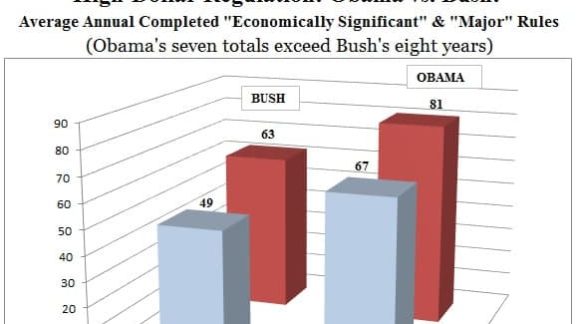Obama’s 7 Years of Regulation Easily Outstrip Bush’s 8

Annually, despite ups and downs, the number of federal rules and regulations tops 3,400.
While the overall rule counts in the Federal Register and the Unified Agenda of Federal Regulations dipped in the past couple years, President Barack Obama’s “pen and phone” promises to go around Congress clearly manifest themselves in other ways.
For example, some rules are bigger than others. The Obama administration’s output of higher impact rules is markedly higher than that of his predecessor, George W. Bush.
The more costly subsets of rules come in two flavors, known as “economically significant,” (generally affecting the economy by $100 million or more annually), and “major,” a slightly broader category than economically significant as each are defined in law and executive orders. Rules can have both labels.
Obama’s totals in each high-impact rule category have already surpassed those of Bush’s entire term.
The twice-yearly Unified Agenda of Federal Regulations is where agencies reveal some proposed and planned rule priorities while also cataloging recently finalized ones. The overall number of “economically significant” rules in the pipeline at various stages (pre-rule, active, completed) was 218 in fall 2015, a nine percent increase over the past year’s 200. President George W. Bush started an uptick that Obama continued with vigor (as can be seen in Figures 19 and 20 in last year’s Ten Thousand Commandments, linked here).
Let’s focus on the completed portion of this flow, compiled from both each year’s spring and fall Unified. Completed economically significant rules from 2008 forward number conspicuously higher than during the earlier part of the decade and even the late 1990s.
As the nearby chart shows, the annual average for completed economically significant rules for Obama’s seven years so far is 67; George W. Bush’s average over his eight years was 49. This even takes into account the fact that only one edition of the Unified Agenda appeared in 2012. Overall, Obama’s total number of economically significant rules completed over seven years is already 468 (as of year-end 2015). Bush’s full-term total: 390.

In a related tally, the Government Accountability Office (GAO) database depicts the number of final major rule reports issued by the GAO regarding agency rules. There were 76 such major rules in 2015 based on GAO’s database, and 81 in 2014.
Bush, over his eight year term, issued 505 major rules according to GAO’s database, compared to Obama’s 570 over just seven years.
As the same nearby chart shows, George W. Bush averaged 63 major rules yearly during his presidential term; President Obama’s seven year average is 81, a 29 percent higher average annual output than that of Bush.
The first regulatory year of the Obama administration may capture some Bush priorities initiated while still in office through most of January of that year. There exists a bipartisan phenomenon of shoving “midnight regulations” into the next guy’s calendar year as scholars at the Mercatus Center and Susan Dudley of the George Washington University Regulatory Studies Center often emphasize. This year, it’ll be Obama’s turn, potentially adding greatly to his regulatory totals if not blocked by congressional action.
Policymakers need to keep an eye on significant and major regulations, but as the “pen and phone” have become more entrenched, the administration and agencies partake of channels outside the normal regulatory process depicted here, such as so-called “guidance documents.” That sub-constitutional rulemaking is what I like to call “Regulatory Dark Matter,” and its costs come on top of what we covered here.